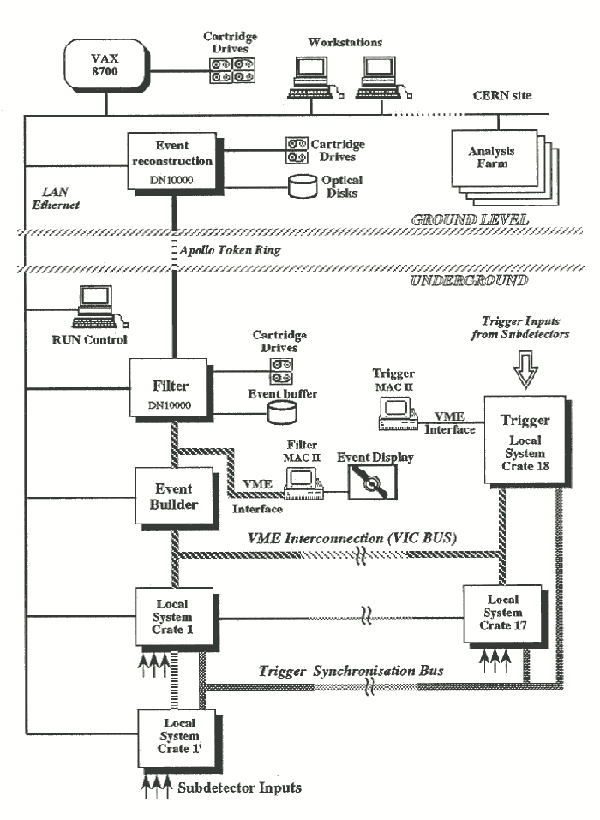

|
Each of the 15 subdetectors handles its own signal collection and data reduction at the level of pedestal subtraction, zero-suppression, pulse shape analysis and track finding. The front-end readout and processing is controlled by a two-processor VME system: a FIC 82308 dedicated to the management of the local operating system (OS9) and a MVME1679 dedicated to the actual readout of the signals from the subdetector. The ensemble is called the local system crate (LSC) and contains at least 5 Mbyte of memory, an ethernet interface, the interface to the front-end digitizers, the local trigger unit (LTU), and a VME crate interconnect. Ten of the subdetectors have two interconnected LSCs on opposite sides of the OPAL detector, with one LSC functioning as the slave and the other serving as the master as well as the common acquisition system for event building. The subdetectors have widely differing detection hardware and digitizer electronics as shown in Table 4.1 [42].
| DET. | CHAN. | SIZE (kB) | DIGITIZER | CRATE | D.T. | |
| Low | High | |||||
| SI | 16000 | 2 | 6 | Ded. TDC | CAMAC | 8 |
| CV | 648 | 2 | 4 | Ded. TDC | EURO | 17.5 |
| CJ | 7680 | 20 | 120 | 100 MHz FADC | EURO-ECL/VME | 18 |
| CZ | 2304 | 2 | 6 | 100 MHz FADC | EURO-ECL/VME | 8 |
| TB | 320 | 2 | 2 | TDC/ADC/PU16 | CAMAC | 10 |
| PB | 21504 | 5 | 5 | Mplxd ADC | EURO/VME | 13 |
| EB | 9440 | 3 | 5 | CIA | FASTBUS | 20 |
| HT | 1472 | 2 | 2 | CIA | CAMAC | 15 |
| HS | 56146 | 1 | 2 | Bit pattern | VME | 5 |
| MB | 1320 | 6 | 6 | TPD | FASTBUS | 20 |
| PE | 6080 | 1 | 2 | Mpxd ADC | EURO/VME | 8 |
| EE | 2264 | 7 | 7 | CIA | FASTBUS | 10 |
| HP | 10576 | 1 | 2 | CIA | CAMAC | 15 |
| ME | 38400 | 2 | 2 | Mpxd ADC | EURO/VME | 7 |
| FD | 4400 | 5 | 5 | 100 MHz FADC | CAMAC | 6 |
| TT | 7 | 7 | FASTBUS | Var. | ||
From the LSC of each subdetector, the data are passed sequentially along to the event builder and the filter. The event builder crate has four interconnected VME crate modules corresponding to four branches into which the 15 subdetectors are grouped. The processor in the event builder crate synchronizes the LSC readout and initiates DMA transfers from the subdetectors. The data are buffered, concatenated, and formatted into a complete event in the dual-port memory of the event builder. The data are then accessible to the filter processors.
The filter processor [43] is located in the filter crate and supervises the multi-event buffer of the events. A fast analysis is performed by the filter processor to aid in the selection and classification of interesting physics events as well as the rejection of obvious background events. The filter program uses the jet chamber tracks, the time-of-flight signals, and muon chamber information for making decisions concerning the selection of events. The filter program manages many data monitoring histograms and also runs in the off-line environment for acceptance of Monte Carlo simulation in physics analysis. The filter algorithm is discussed in detail in the Section 4.4.
After the filter, events are transferred from the underground experimental area via an optical link10 to the main processor at ground level. The events are are buffered by an optical disk and a Hewlett-Packard DN10000 performs event reconstruction in real time. The program used to reconstruct events from digits from the OPAL detector or from the OPAL simulation program, GOPAL, is called ROPE [44]. The ROPE reconstruction is implemented in the on-line environment through a collection of Apollo workstations at ground level in the barrack at interaction point 6 (I6). Reconstruction is performed as the calibration constants for the subdetectors become available, usually within an hour of the events being taken. All ROPEd events classified into various event types such as Bhabha, m-pair event, t-pair event, multihadronic Z0 decay, and flagged luminosity events and transmitted with the data summary tape (DST) blocks to magnetic tape cartridges for later physics analysis.
The data are transmitted to the disks in the off-line VAX cluster for semi-permanent residence to perform analysis. The data are copied from this disk over the network to the main CERN site - to the SHIFT analysis farm, to the off-line VAX cluster and to CERNVM. On SHIFT, the partitions from each data-taking run (usually corresponding to one fill of LEP) are collated, and events passing the FYZ1 selection are stripped off. The headers of the full data set are also stripped, to make an ``off-line nanodst'', which is compared to the ``filter nanodst'' to check if events were lost in the data reconstruction processing. The fully ROPEd dataset is archived to cartridge in the computer center and the VAX disk copy deleted.
Software Control and Monitoring
One of the keys to the smooth running of the on-line data processing is the dependability and homogeneity of the software. All subdetector processors in VME run the OS9 operating system11 with the common programming languages of Assembler [45], C [46], and RTF FORTRAN [45]. The networking protocols over the ethernet local area network (LAN) between processors in VME crates, the VAX 8700, workstations, and the CERN main site include OS9Net [47], DECNet, TCP/IP, and CATS [48]. The underlying format of the data structure for the data from the LSCs on is the ZEBRA data structure [49].
The data acquisition system is controlled by the on-line VAX cluster for the event builder and by each LSC for the subdetector. The software is based on the MODEL suite of programs available from the CERN Data Division12. The main features of the control system and interface to the subdetectors are:
A control system [51] ensures the safe operation of the detector and serves as a homogeneous interface between the subdetectors and the general infrastructure of the experiment. The system supervises the common environment including safety aspects and the aspects of the experiment specific to each subdetector. The parameters of the common infrastructure such as voltages, gas flows, temperatures, etc., are continuously monitored by seven VME micro computer stations distributed over the experimental site. All values are continually compared to their nominal settings and stored to a file. When problems arise, the system notifies the operator and takes automatic corrective actions if required. The control stations are always operational and interface to the LEP-wide security systems, which is globally monitored by a single station in the control room of the OPAL experiment.
The origin of all OPAL trigger signals comes from the separate subdetector trigger signals which are used either separately or in coincidence with each other. Implementation of the system is in two separate parts: firstly, the individual subdetector trigger signals and secondly, the q and f (q-f matrix) signals which are synthesized by the central trigger logic processor resulting in collective triggering. Used separately, the subdetector trigger signals such as total energy can trigger events with high thresholds, while used in spatial coincidence with other subdetector q-f elements, the signals can trigger with lower thresholds allowing the system to attain a very high level of redundancy and efficiency in triggering.
The subdetectors which provide independent triggers include the vertex chamber, the jet chamber, the time-of-flight detector, the electromagnetic calorimeter (barrel and endcap), the hadron calorimeter (barrel and endcap) and pole tip, the muon chambers (barrel and endcap), and the forward detectors. Direct trigger signals from the subdetectors are summarized in Table 4.2 [52].
| NAME | DET. | SIGNAL DESCRIPTION | RATE |
| TM1 | TT | ³ 1 Trk | 8 |
| TM2 | TT | ³ 2 Trk | 1 |
| TM3 | TT | ³ 3 Trk | 0.2 |
| TBM1 | TT | ³ 1 Barrel Trk | 0.4 |
| TBM2 | TT | ³ 2 Barrel Trk | 0.2 |
| TBM3 | TT | ³ 3 Barrel Trk | 0.1 |
| VXH | TT | ³ 8 Hits in Vertex Chamber | 400 |
| J1H | TT | ³ 8 Hits in Jet Chamber Ring 1 | 150 |
| J2H | TT | ³ 8 Hits in Jet Chamber Ring 2 | 70 |
| J3H | TT | ³ 8 Hits in Jet Chamber Ring 3 | 50 |
| TOFOR | TOF | ³ 1 Time-of-flight Hit | 20 |
| TOFMANY | TOF | ³ 7 Overlapping TOF q-f Bins | 0.2 |
| TOFMUL | TOF | TOF Bars Hit above Threshold | 2 |
| EBTOTHI | EM | EEB tot. ³ 7 GeV | 0.1 |
| EELHI | EM | EEE left ³ 6 GeV | 0.06 |
| EERHI | EM | EEE right ³ 6 GeV | 0.06 |
| EBTOTLO | EM | EEB tot. ³ 4 GeV | 10 |
| EELLO | EM | EEE left ³ 4 GeV | 0.5 |
| EERLO | EM | EEE right ³ 4 GeV | 0.5 |
| EBTPHI | EM | ³ 1 q-f w/ EEB ³ 2.6 GeV | 0.2 |
| EELTPH | EM | ³ 1 q-f w/ EEE left ³ 3 GeV | 0.1 |
| EERTPH | EM | ³ 1 q-f w/ EEE right ³ 3 GeV | 0.1 |
| MBH | MU | ³ 1 MB | 500 |
| MEL | MU | ³ 1 ME in Left | 20 |
| MER | MU | ³ 1 ME in Right | 20 |
| MELR | MU | ³ 1 ME in Left AND Right | 0.2 |
| FDSUM | FD | SEleft,right ³ 15 GeV | 0.3 |
| FDSEG | FD | SEleft,right seg. ³ 13 GeV | 0.35 |
| FDHIOR | FD | EFD ³ 35 GeV | 0.3 |
| FDSUMA | FD | FDSUM Accidental Trig. | 0.05 |
| FDSEGA | FD | FDSEG Accidental Trig. | 0.005 |
| LCALLO | FD | EFD left ³ 15 GeV | 4 |
| RCALLO | FD | EFD right ³ 15 GeV | 4 |
| BXRSA | RAN | CTL | 0.04 |
The actual q-f matrix consists of 144 overlapping q-f bins with 6 bins in q and 24 bins in f. The q-f matrix has nearly 4p coverage in solid angle of the detector as shown in Table 4.3 [52]. The q-f matrix has five layers corresponding to the track, time-of-flight, electromagnetic, hadron, and muon triggers. This is shown schematically in Figure 4.2 [52] with the output triggers listed in Table 4.4 [52]. The direct event triggering along with the trigger input signals provided to the central trigger logic are summarized in Table 4.2.
| BIN q | RANGE q | ||
| 1 | -0.980 | to | -0.596 |
| 2 | -0.823 | to | -0.213 |
| 3 | -0.596 | to | 0.213 |
| 4 | -0.213 | to | 0.596 |
| 5 | 0.213 | to | 0.823 |
| 6 | 0.596 | to | 0.980 |
| BIN f | RANGE f | ||
| 1 | 0° | to | 30° |
| 2 | 15° | to | 45° |
| 3 | 30° | to | 60° |
| ··· | ··· | ||
| 23 | 330° | to | 360° |
| 24 | 345° | to | 15° |
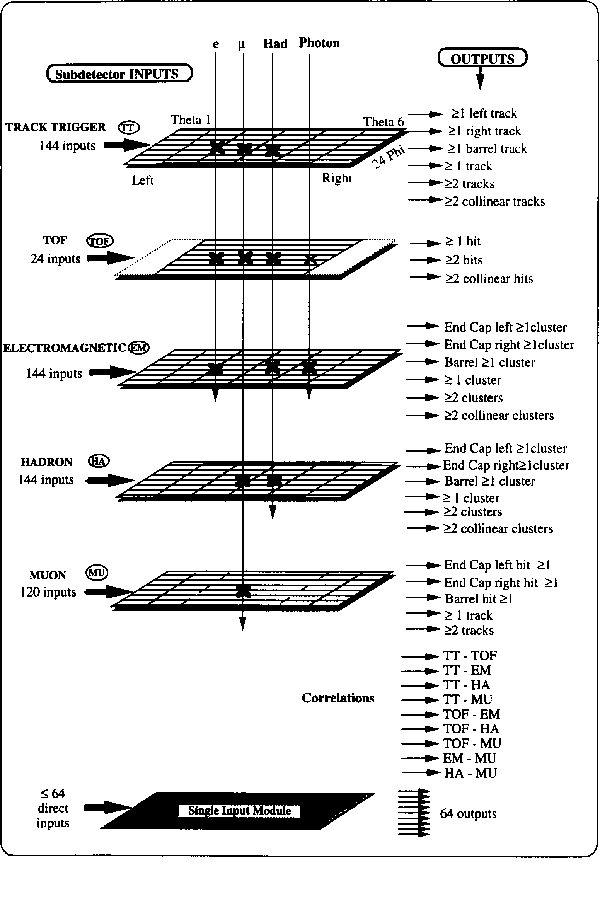
|
| NAME | SIGNAL DESCRIPTION | RATE |
| TPTTB | Trk. Trig., ³ 1 q-f in q2-5 (barrel) | 1 |
| TPTT1 | Trk. Trig., ³ 1 q-f Bin | 8 |
| TPTT2 | Trk. Trig., ³ 2 Independent q-f Bins | 1 |
| TPTTL | Trk. Trig., ³ 1 f Bin in q1 | 5 |
| TPTTR | Trk. Trig., ³ 1 f Bin in q6 | 5 |
| TPTTCL | Trk. Trig., ³ 1 pair of Collinear tracks | 0.15 |
| TPTTTO | Trk. Trig. AND TOF, ³ 1 Correlated q-f Bin | 0.3 |
| TPTTEM | Trk. Trig. AND EM, ³ 1 Correlated q-f Bin | 0.15 |
| TPTTHA | Trk. Trig. AND Hadron, ³ 1 Correlated q-f Bin | - |
| TPTTMU | Trk. Trig. AND Muon, ³ 1 Correlated q-f Bin | 0.03 |
| TPTO1 | TOF, ³ 1 q-f Bin | 20 |
| TPTO2 | TOF, ³ 2 Independent q-f Bins | 2 |
| TPTOCL | TOF, ³ 1 pair of coplanar hits | 0.4 |
| TPTOEM | TOF AND EM, ³ 1 Correlated q-f Bin | 0.25 |
| TPTOHA | TOF AND Hadron, ³ 1 Correlated q-f Bin | - |
| TPTOMU | TOF AND Muon, ³ 1 Correlated q-f Bin | 0.2 |
| TPEMB | EM, ³ 1 q-f Bin in barrel | 100 |
| TPEM1 | EM, ³ 1 q-f Bin | 120 |
| TPEM2 | EM, ³ 2 Independent q-f Bins | 0.2 |
| TPEML | EM, ³ 1 f Bin in q1 | 10 |
| TPEMR | EM, ³ 1 f Bin in q6 | 10 |
| TPEMCL | EM, ³ 1 pair of Collinear clusters | 0.15 |
| TPEMMU | EM AND Muon, ³ 1 Correlated q-f Bin | - |
| TPHAB | Hadron, ³ 1 q-f Bin in barrel | 200 |
| TPHA1 | Hadron, ³ 1 q-f Bin | - |
| TPHA2 | Hadron, ³ 2 Independent q-f Bins | - |
| TPHAL | Hadron, ³ 1 f Bin in q1 | - |
| TPHAR | Hadron, ³ 1 f Bin in q6 | - |
| TPHACL | Hadron, ³ 1 pair of Collinear clusters | - |
| TPHAMU | Hadron AND Muon, ³ 1 Correlated q-f Bin | - |
| TPMUB | Muon, ³ 1 q-f Bin in barrel | 500 |
| TPMU1 | Muon, ³ 1 q-f Bin | 500 |
| TPMU2 | Muon, ³ 2 Independent q-f Bins | 10 |
| TPMUL | Muon, ³ 1 f Bin in q1 | 20 |
| TPMUR | Muon, ³ 1 f Bin in q6 | 20 |
The central trigger consists of a special crate with up to nine monoboard VME cards and ten specific function VME cards. One VME card receives up to 64 stand-alone signals from the subdetectors and allows a variety of logical conditions to be imposed on signals, both direct and from q-f , which results in the trigger and digitization of the event. The central trigger logic receives the direct subdetector signals (refer to Table 4.2) and the q-f signals (refer to Table 4.4) 1 to 14 ms after the bunch crossing and then makes a decision to send a trigger signal to the subdetectors to start data acquisition 7 ms before the next bunch crossing. A detailed view of the trigger process with its relation to the beam crossings is shown in Figure 4.3 [52].
In actual implementation, the central trigger logic is composed of the following components:
The central trigger crate is well integrated into the OPAL data acquisition system via the Ethernet Local Area Network (ELAN). This communication allows valuable operator control of relevant run and trigger parameters as well as instantaneous feedback in the form of histograms on detector performance and background conditions. Testing is also performed before each run and important information concerning the assignment of trigger signals to SIM inputs, the PAL logic, and the logical conditions to be imposed on the PAM inputs, is stored on mass media. In addition to beam-synchronized operation, the central trigger logic allows for triggering cosmic rays by gating from scintillation counters above the detector. An unbiased random trigger at a pre-scaled rate of 0.04 Hz also provides samples of null events, which are particularly useful in monitoring noise levels in the subdetectors.
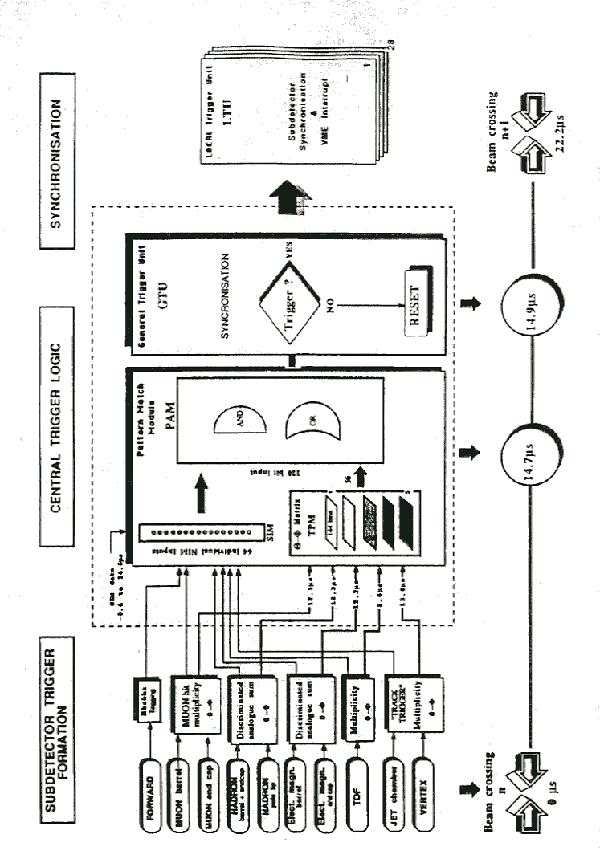
|
As expected from their similar topologies, these event types have a high degree of correlation in triggering as shown in Table 4.5 [52]. The fact that the triggering of the single photon events is a subset of the other event types is important in studying the efficiencies for the single photon events. In general, the selection criteria for the single photon events were chosen to retain the maximum signal from the e+e-® n[`(n)]g process, while reducing as much as possible the background rates and allowing the flexibility of selecting other event types, like the tagged photon and single electron events. The tagged photon events are used as a check of the forward detector simulation and the systematics. The single electron events are used to determine the trigger and event selection efficiencies and to check the background veto capability and the calorimeter response to electromagnetic showers. The results of studies with the tagged photon events and the single electron events are discussed along with that of the single photon events where applicable.
| TRIGGER | DESCRIPTION | SINGLE | TAGGED | SINGLE |
| Photon | Photon | Electron | ||
| TPTOEM | TOF AND EM | Ö | Ö | Ö |
| ³ 1 Correlated q-f Bin | ||||
| EBTPHI | ³ 1 q-f Bin | Ö | Ö | Ö |
| with EEB > 2.6 GeV | ||||
| EELTPH | ³ 1 q-f Bin | Ö | Ö | Ö |
| with EEE left > 3 GeV | ||||
| EERTPH | ³ 1 q-f Bin | Ö | Ö | Ö |
| with EEE right > 3 GeV | ||||
| TPTTEM | Trk. Trig. AND EM | Ö | ||
| ³ 1 Correlated q-f Bin | ||||
| TPTTTO | Trk. Trig. AND TOF | Ö | ||
| ³ 1 Correlated q-f Bin | ||||
The trigger implementation used for the 1991 run is summarized in Table 4.6 [52]. The stable running of LEP during the run allowed for the easy optimization of the trigger conditions to keep the trigger rate below the maximum rate tolerable by the data acquisition system and provide good efficiency for all considered physics processes. The redundancy for all physics processes was achieved by triggers based on one detector component and sensitive to single particles. The trigger rate is a function of the machine luminosity, the beam-related backgrounds, and at a constant level the cosmic rays and detector noise. As a result, single particle triggers from only one subdetector were not possible due to the high rates from such considerations [54]. The q-f coincidences between detector layers had low rates, even for low thresholds, because the coincidences suppressed random noise and low energy backgrounds seen only in one layer. The rates of the low threshold ECAL triggers and the muon barrel trigger were mainly due to noise, while the track trigger and the TOF system were dominated by beam related backgrounds. The rates for triggering averaged over the 1991 run are shown in Table 4.6.
| NAME | TRIGGER CONDITION | RATE |
| TM3 | More than 3 Tracks | 0.2 |
| TBM2 | More than 2 Tracks in Barrel | 0.2 |
| TPTTCL | Track Trig. Collinear q-f Bins | 0.15 |
| TPTTTO | Track Trig. - TOF q-f Coinc. | 0.3 |
| TPTTEM | Track Trig. - EM q-f Coinc. | 0.15 |
| TPTTMU | Track Trig. - Muon q-f Coinc. | 0.03 |
| TOFMANY | ³ 7 Overlapping TOF q-f bins | 0.2 |
| TPTOMU | - Muon q-f Coinc. | 0.2 |
| TPTOEM | TOF - EM q-f Coinc. | 0.25 |
| TOFMUL.AND. | TOF-Based Single Phot. Trig. | 0.1 |
| .NOT.(TPTO2.OR.J1H) | ||
| EBTOTHI | EEB tot. ³ 7 GeV | 0.1 |
| EELHI.OR.EERHI | EEE tot. ³ 6 GeV | 0.1 |
| EBTPHI | EEB q-f ³ 1 Bins ³ 2.6 GeV | 0.2 |
| EELTPH.OR.EERTPH | EEE q-f ³ 1 Bins ³ 3.0 GeV | 0.15 |
| TPEMCL | ECAL , Collinear q-f Bins | 0.15 |
| EEL(R)LO | EEB tot. ³ 4 GeV | 0.03 |
| .AND.EBTOTLO | AND E1 EE tot. ³ 4 GeV | 0.03 |
| EELLO.AND.EERLO | EEE ³ 4 GeV in Both EE | 0.04 |
| EEL(R)LO | EEE ³ 4 GeV | 0.08 |
| .AND.TPTTR(L) | AND Opp. Trk. | |
| EEL(R)LO.AND.TBM1 | EEE ³ 4 GeV AND ³ 1 Barrel Trk. | 0.05 |
| TPEML(R).AND.TBM1 | EE q-f Bin AND ³ 1 Barrel Trk. | 0.10 |
| TPEML(R) | EE q-f | 0.15 |
| .AND.TPTTR(L) | AND Opp. Trk. | |
| EBTOTLO.AND. | EEB ³ 4 GeV AND | 0.2 |
| (TBM1.OR.TOFOR) | 1 Barrel Trk. or TOF Hit | |
| MELR | Muon in Left AND Right ME | 0.2 |
| MEL(R).AND. | ³ 1 ME AND | 0.2 |
| (TBM1.OR.TOFOR) | 1 Barrel Trk. or TOF Hit | |
| MEL(R).AND.TPTTR(L) | Muon in ME AND Opp. Trk. | 0.02 |
| FDSUM | EFD ³ 15 GeV on Both Sides | 0.35 |
| FDSEG | EFD ³ 13 GeV Back-to-Back | 0.3 |
| FDSEGA | FD Accidental | 0.005 |
| L(R)CALLO | EFD ³ 15 GeV AND | 0.04 |
| .AND.EBTOTLO | EEB ³ 4 GeV | |
| L(R)CALLO.AND.TBM1 | EFD ³ 15 GeV AND ³ 1 Barrel Trk. | 0.03 |
| BXRSA | Random Beam Crossing | 0.04 |
With these simple definitions, the filter algorithm operating in parallel under the coordination of the MODEL buffer manager selects and classifies events. The result of the filter processing is registered in a 32 bit filter word which is recorded along with the LEP run parameters in the 64 word event header which is then used to make a decision to accept or reject the event. For events which are accepted, data compression is performed reducing the data volume by a factor of five before transmission of the event for complete reconstruction.
From the filter, events are passed through a reconstruction process to convert all the ``raw'' subdetector data into physical quantities such as particle energies. The process operates asynchronously from the data acquisition due to the dependence on the calibration constants from the OPAL Calibration (OPCAL) data base. OPCAL [55] is a set of programs designed to allow storage and retrieval of calibration data from the OPAL subdetectors. The reconstruction process provides a quick feedback to the shift people responsible for the quality of the collected data during the operation of LEP. The full event reconstruction requires 26 CPU seconds for the average hadronic Z0 decay and 2 CPU seconds for other events with an average throughput of 4 events per second. The reconstruction uses the ORACLE data base14 to maintain a history of each data file, store information on the number and types of events, and store the calibration files. Before sending the input and output compressed data files for storage, the reconstruction algorithm determines the event-type classifications. For the purposes of the analysis presented in this thesis, event types important to the selection of single photon events are determined from the filter algorithm and summarized in Table 4.7 [56]. The most general acceptance is the FYZ1 selection which is the synthesis of all other types of preselection and selection including luminosity, lepton pair, single photon, converted photon, heavy lepton, two photon, Higgs, multihadron (Tokyo criteria), luminosity filter, gold-plated filter, and other special triggers.
| EVENT TYPE | DESCRIPTION | BIT |
| IEGAM | S Ecluster > 0.7 GeV, | 8 |
| D q,D f < 0.2 rad | ||
| IEGSTR | Special Single Photon Event | 14 |
| IEGEMT | S Ecluster > 0.7 GeV | 24 |
| D q,D f < 0.2 rad, | ||
| and > 1 TOF hit | ||
| IEGEM | S Ecluster > 5.0 GeV, | 27 |
| S E2 cluster < 0.2 GeV, | ||
| Nblocks > 2, 0.15 < fmax < 0.99 | ||
| IEFYZ1 | Pass Any Physics Preselection Selection | 32 |
| Preselection or Selection | 32 | |
| IELLQQ | Lepton Pair High Multiplicity | 4 |
| IEGVMU | Muon Veto | 22 |
| IEGVBW | Beam Wall Veto | 23 |
| EXP. | PER. | RUNS | DATES | ENGY. | PASS | L(nb-1) |
| 1 | 8 | 1419-1498 | 23/03-01/04 1990 | Peak | Pass 4 | 215.7±3.1 |
| 1 | 9 | 1535-1597 | 10/04-23/04 1990 | Scan | Pass 4 | 679.6±5.5 |
| 1 | 10 | 1632-1703 | 30/04-14/05 1990 | Scan | Pass 4 | 674.7±5.5 |
| 1 | 11 | 1737-1756 | 22/05-27/05 1990 | Scan | Pass 4 | 305.1±3.7 |
| 1 | 12 | 1775-1792 | 31/05-05/06 1990 | Scan | Pass 4 | 419.7±4.3 |
| 1 | 13 | 1801-1810 | 07/06-12/06 1990 | Scan | Pass 4 | 343.1±3.9 |
| 1 | 14 | 1840-1846 | 30/06-01/07 1990 | Scan | Pass 4 | 266.2±3.5 |
| 1 | 15 | 1852-1882 | 08/07-17/07 1990 | Scan | Pass 4 | 518.1±4.8 |
| 1 | 16 | 1885-1897 | 20/07-24/07 1990 | Scan | Pass 4 | 592.3±5.2 |
| 1 | 17 | 1917-1924 | 02/08-07/08 1990 | Scan | Pass 4 | 370.2±4.1 |
| 1 | 18 | 1929-1942 | 09/08-14/08 1990 | Scan | Pass 4 | 771.1±5.9 |
| 1 | 19 | 1951-1974 | 18/08-29/08 1990 | Scan | Pass 4 | 1457.6±8.1 |
| 2 | 20 | 2205-2230 | 17/04-22/04 1991 | Peak | Pass 3 | 70.6±1.8 |
| 2 | 21 | 2258-2271 | 30/04-06/05 1991 | Peak | Pass 3 | 693.4±5.6 |
| 2 | 22 | 2282-2299 | 08/05-13/05 1991 | Peak | Pass 3 | 524.4±4.8 |
| 2 | 23 | 2316-2330 | 18/05-26/05 1991 | Peak | Pass 3 | 1164.3±7.2 |
| 2 | 24 | 2338-2345 | 30/05-02/06 1991 | Peak | Pass 3 | 730.3±5.7 |
| 2 | 25 | 2354-2360 | 07/06-12/06 1991 | Peak | Pass 3 | 1027.0±6.8 |
| 2 | 26 | 2363-2377 | 13/06-20/06 1991 | Peak | Pass 3 | 1545.6±8.3 |
| 2 | 27 | 2393-2406 | 10/07-16/07 1991 | Peak | Pass 3 | 611.1±5.2 |
| 2 | 28 | 2408-2441 | 19/07-07/08 1991 | Peak | Pass 3 | 1677.2±8.7 |
| 2 | 29 | 2461-2480 | 17/08-26/08 1991 | Scan | Pass 3 | 1635.4±8.6 |
| 2 | 30 | 2500-2517 | 05/09-11/09 1991 | Scan | Pass 3 | 1841.5±9.1 |
| 2 | 32 | 2536-2559 | 11/10-23/10 1991 | Scan | Pass 3 | 2231.2±10.0 |
| 2 | 33 | 2566-2582 | 27/10-06/11 1991 | Scan | Pass 3 | 1722.1±8.8 |
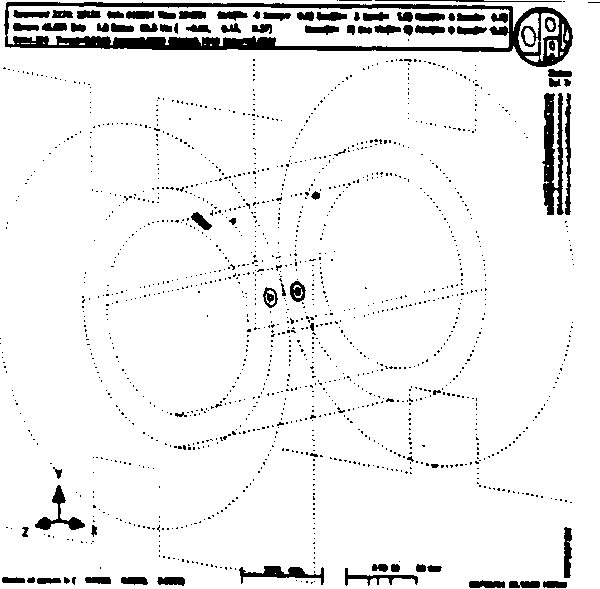
|
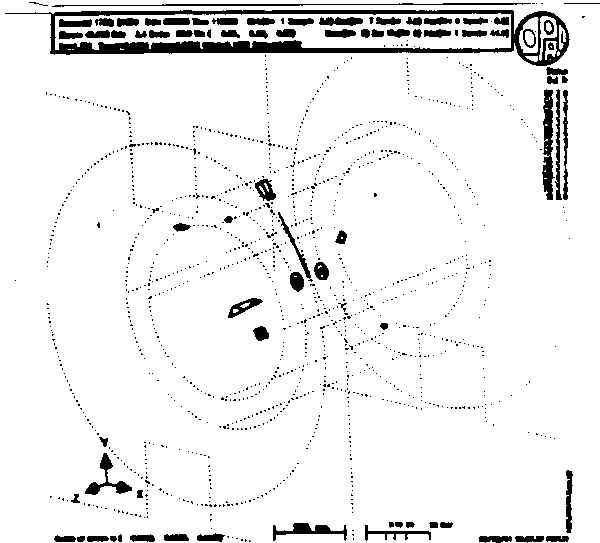
|